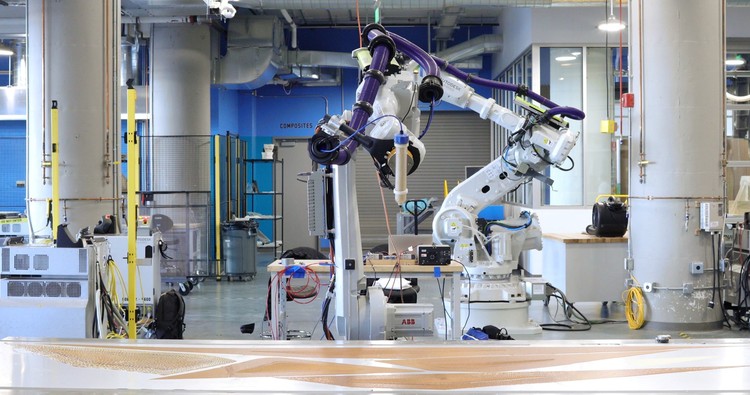Digital Fabrication in Architecture
Overview
The potential of Digital fabrication in Architecture is increasingly grabbing headlines for a while now. Architects and universities all around the world are discussing projects and experiments to garner the full benefits of technology for architecture practice. Therefore, it is only right to understand today the impact technology has had so far on this profession. Covering the different processes within the field and the projects, this article discusses the architectural potential of digital fabrication.
Types of Digital Fabrication
The term digital fabrication can be used for any manufacturing process that is controlled by a computer. With all the advancements in technology, things are changing rapidly to suit the needs of the architect. However, digital fabrication mainly revolves around one or more of three methods: Additive manufacturing, subtractive manufacturing and robotic manipulation.
1. Additive Manufacturing

Additive manufacturing or material layering is another name for 3D printing. Right from its invention in 1983, the technology found applications in various fields. 3D printing involves a process known as Stereolithography (SLA), a process in which a laser is beamed into a mass of photopolymer that is turned into plastic. However, Additive manufacturing is no longer limited to plastic. Materials like metals, glass, clay, nanocomposites and even human tissue can be used!
Layered architecture is making headlines throughout the world now and is a good application of digital fabrication for architects.
2. Subtractive Manufacturing

Subtractive manufacturing deals with carving objects out of solid blocks mainly by CNC milling. With recent digital advancements, equipping CNC milling with robotic arms further enhanced its capabilities, resulting in better precision and efficiency. The conventional modelling techniques like Laser-cutting and hot wire, are also a part of subtractive manufacturing.
3. Robotic Manipulation

Robots find applications in architecture for a wide range of processes like folding and weaving. Robotics has opened doors to endless possibilities by creating highly customizable machines. For example, recently, MIT grabbed headlines for its Fiberbots project, a robotic manufacturing process for digital fabrication of large scale objects and structural elements using weaving and free-form printing.
Architectural Applications

Technology is increasingly showing its full potential for a profession like architecture. With 3D printed houses and steel bridges being built already, one can only wonder the extent of applications of technology in today’s world. Here are some real-life architectural applications of digital fabrication :
Automating Construction Processes

With projects like SAM (the semi-automated mason), a robot capable of laying bricks three times the speed of a human, already being built for large scale construction processes, digital fabrication is quickly changing the ways of construction.
ETH Zurich’s automated construction of timber-framed structures is one small example of what technology can achieve in years to come. With every part of the process like cutting, drilling and assembly being automated, we get to experience a more efficient and streamlined construction.
Innovative Building Materials

Developing improved building materials is another application of digital fabrication. One example is Neri Oxman’s and MIT’s research project called Aquahoja. Employing biodegradable and environmentally friendly materials like chitosan, pectin, cellulose and water, Aquahoja opens doors to a more sustainable world.
With active research going on all around the world, we are yet to reach the full potential of digital fabrication. Organisations like MIT’s Mediated Matter Group are actively involved in building improved materials.
Optimizing form and Material Usage
As shown by the Smart Slab developed by ETH Zurich, digital fabrication allows an efficient, high precision design and fabrication process. The concrete slab made up of a 3D printed framework is designed for minimal use of material necessary for load-bearing.
Improved aesthetics
Digital fabrication in architecture is opening doors to improved aesthetics and impeccable designing. Allowing intricate patterns with degrees of geometric complexity, digital manufacturing makes things dramatically easier with little or no impact on costs. Greg Lynn is one of the pioneers in making use of digital fabrication by using the carving machine to create aesthetically pleasing designs.
The Concrete Choreography project, developed at the ETH Zurich further exemplifies the versatility and potential of digital fabrication in architecture, making use of different ornamentation and textures.
Digital fabrication and Open-Source Design
With the spread of digital fabrication technologies, the open-source design is increasingly making headlines. An open-source spherical garden from Space 10 called the Growroom, became popular for its easily replicable design. Other platforms like WikiHouse are also taking advantage of digital fabrication in the present scenario.
Digital fabrication is still in its infancy within the architecture practice. However, it has captured the imagination of architects and academia, therefore it might not be long before this body of work reaches a critical mass, thus penetrating main-stream design workflow. The advent of digital fabrication within the architectural field adds up to the profound changes that call for a reinvention of the profession.
Conclusion:
Technology has impacted almost every field today. With research going on around the world, our understanding of technologies like digital fabrication is only beginning to evolve. Digital fabrication in this day and age is increasingly becoming popular for extensive applications in the architecture practice.









